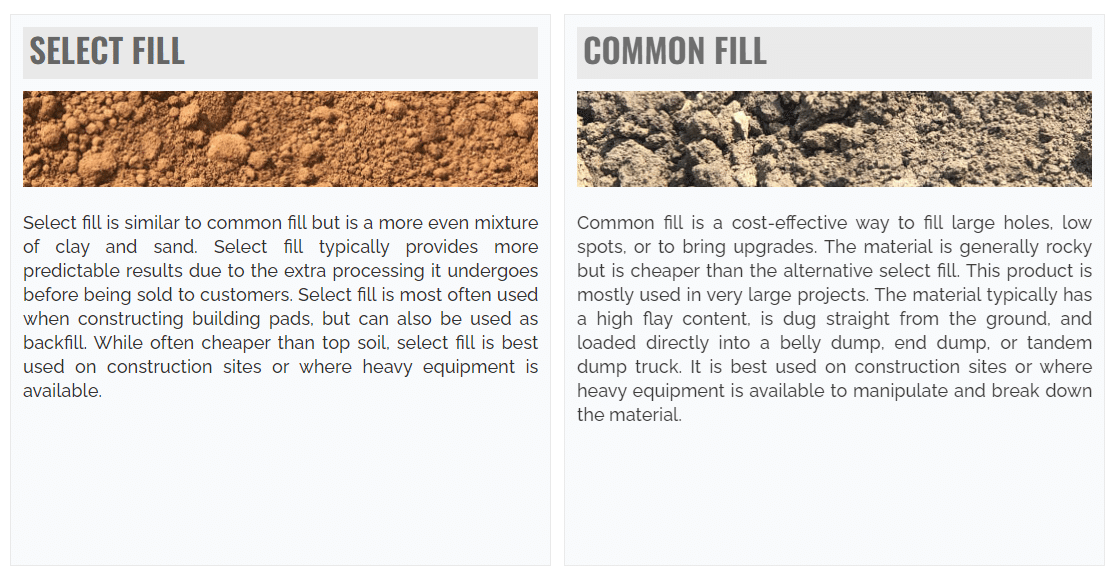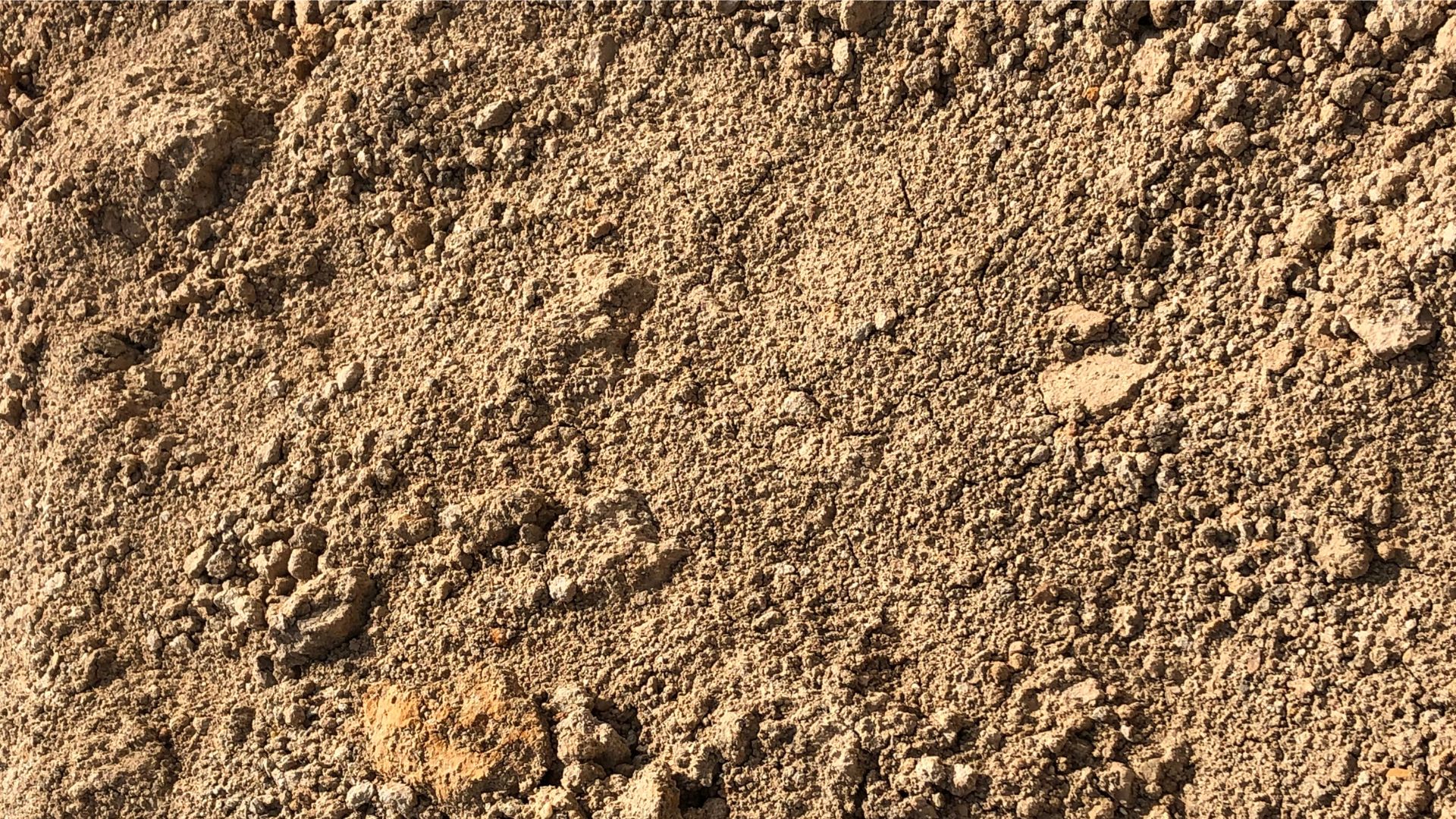What Is Fill Dirt?
Fill dirt is a generic term used to describe materials that consist of some combination of clay and sand. Fill dirt occurs naturally and, while it is possible to manufacture, it is typically abundant and significantly less expensive to naturally mine.
Select fill and common fill have the same basic composition: clay and sand. The materials are both mined naturally and do not require further processing by the quarry. While both materials are used in building projects, Select Fill is held to a higher standard and the name indicates that the material will pass the material testing standards set by the local and state governments.

There are two primary types of Fill Dirt: Select Fill and Common Fill. The materials are similar in composition and both occur naturally. The key difference between Select Fill and Common Fill is the ratio of Sand and Clay in the product, with Select Fill implying that the fill material will pass state specifications for composition. While common fill can consist of any combination of clay and sand material, select fill will conform to a specific ratio set by the local authority and will be a higher quality dirt as a result.
Why Fill Dirt Is Great for Rainy Areas
Select and Common Fill are excellent at compacting and providing stability for a multitude of projects that anticipate rain and water. These materials are used as a base layer to provide stability to buildings, homes, and other residential and commercial projects. Due to the materials dense nature, it is perfect for leveling or elevating the ground. Generally, select fill is used beneath the concrete foundations of buildings or for smaller projects like filling in swimming pools. Common fill, however, is a cost effective way to landscape large areas that are not being prepped for building. In both cases, using the materials to fill in areas is an efficient way to ensure an area stays strong for many years to come.
Fill Dirt Alternatives
Since there are so many types of fill dirt, it’s relatively simple to find an option that works best for you. The following is a list of materials that can be used as alternatives to select and common fill.
1. Topsoil
Topsoil is a mix of compost and sand that helps things grow. It is used for the top layer of dirt or soil, so it would usually be placed above another type of fill dirt which must be put down first as a foundation. However, in some cases, topsoil can be used on its own, though a layer of fertilizer is recommended on top.
2. Compost
Compost itself is actually a type of fill dirt. Once natural materials such as food scraps have fully decomposed, they turn into dirt and can be used to nourish the earth or patch up holes on the lawn. Plus, compost can be completely free—you can start your own compost heap right in your backyard.
3. Rock Fill Dirt
Rock fill dirt contains more stones and rocks than common fill, so it’s especially good for filling in large holes which don’t need to grow grass or plants.
4. Septic Fill Dirt
A great option for moist areas, septic fill dirt is impervious to water and will protect the ground around it. As such, it is often placed around septic tanks.
5. Red Fill Dirt
Red Fill dirt is a term that can be used to describe both common and select fill found in Central Texas. The name originates from the materials distinctive red coloring, which is a result of the heavy clay content in the material.
Cost of Fill Dirt Compared to Alternatives
Fill dirt is varied and can be found in abundance, likely very close to your project. As such, the material is often among the cheapest that can be purchased. The cost of dirt is determined by the quality of material as well as the quantity that needs to be provided. To estimate how much fill dirt is needed for your project, calculate the volume of your project by multiplying the depth, length, and width of the area that you’d like to fill. It is important that you choose the correct material for your intended use and it is not recommended that substitutes be used in an effort to save costs. Using improper select fill can lead to many problems down the road, including foundation shifting.

How to Order Fill Dirt in Texas
The hardest parts of ordering fill dirt are finding a reputable supplier and a trucking company to deliver the material. The material is abundant and relatively cheap, making it accessible to all sizes of construction and landscaping projects. The professionals at Twisted Nail have the know-how and experience to ensure you are paired with the appropriate material and receive your delivery in a timely manner. Whether you’re looking for a small amount for a residential project or a few thousand tons for industrial or commercial projects, we’ve got you and your team covered. We will guide you through the decision making and ordering process, ensuring that your fill dirt arrives on time and at the location of your choosing.
Contact Twisted Nail for Fill Dirt in Texas Today!
FAQs
How can I determine the quantity of fill dirt needed for my project?
To determine the quantity of fill dirt needed for your project, measure the length, width, and desired depth of the area to be filled. Multiply these measurements together to calculate the volume of fill dirt required. It is advisable to add a contingency factor to account for compaction and settling.
Can fill dirt be used for both residential and commercial applications?
Yes, fill dirt can be used for both residential and commercial applications. It is commonly used for foundation backfill, landscaping projects, site grading, and other construction purposes in various settings.
What is the recommended depth for placing fill dirt in different applications?
The recommended depth for placing fill dirt depends on the specific application and desired outcome. In general, it is important to consider factors such as the load-bearing requirements, compaction capabilities, and the intended use of the filled area to determine the appropriate depth.
Can fill dirt be used for grading or leveling uneven surfaces?
Fill dirt can be used for grading or leveling uneven surfaces. By adding and compacting the fill dirt in layers, it helps create a more even and stable surface for further construction or landscaping activities.
Are there any specific considerations for using fill dirt in areas prone to heavy rainfall or flooding?
When using fill dirt in areas prone to heavy rainfall or flooding, proper drainage considerations should be made. This may include ensuring proper slope and contouring, installing drainage systems, or using specific fill materials that promote water infiltration and drainage.
Is there a difference in quality between select fill and common fill dirt?
Common and Select Fill are technically the same material, but at varying levels of clay. Fill is tested by measuring the % of sand vs clay mixed into the material. Common fill refers to material that is not tested or does not pass testing. This material will either have too much clay or too much sand to be used for structural projects. Select fill refers to material that meets regulation regarding the mix of clay and sand. This material is higher quality and is suitable for foundations and other structural projects.
Are there any environmental benefits to using fill dirt?
Using fill dirt can have environmental benefits, such as reducing the need for disposal of excess soil and minimizing the extraction of natural resources. Proper sourcing and handling of fill dirt can also promote land reclamation and conservation efforts.
What are the advantages of sourcing fill dirt from a local supplier in Texas?
Sourcing fill dirt from a local supplier in Texas offers advantages such as reduced transportation costs, shorter lead times, and the ability to select materials that are well-suited to the local soil conditions and requirements.
Can fill dirt be used for creating embankments or building up slopes?
Fill dirt can be used for creating embankments or building up slopes. By layering and compacting the fill dirt, it helps reinforce the slope of embankment and provides stability against erosion or slope failure.
Are there any recommended techniques for spreading and leveling fill dirt?
Recommended techniques for spreading and leveling fill dirt include using grading equipment, such as bulldozers or skid steers, to evenly distribute the material and achieve the desired slope or contour. Proper compaction techniques should also be employed to ensure stability.